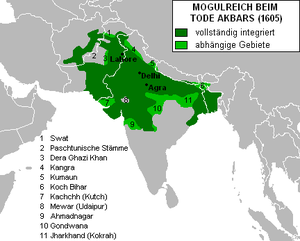- Mughal-Rajput War (1558-1578)
-
Mughal-Rajput War Part of Mughal Empire 
Territories of the Mughal Empire and the Rajputs.Date 1558-1578 Location India Result Mughal victory Belligerents  Mughal Empire
Mughal Empire Mewar
Mewar
 Rajputs
RajputsCommanders and leaders Akbar  Udai Singh
Udai Singh
 Jaimal and Patta†
Jaimal and Patta†
 Pratap Singh
Pratap Singh
 Rana Jai Singh
Rana Jai Singh
 Shakti Singh
Shakti SinghStrength Varies Varies Casualties and losses Varies Varies The Mughal-Rajput War (1558-1578) was a conflict between the Mughal Empire of India and the local Hindu princes, the Rajputs.
War
Mughal Emperor Akbar came to power in 1556, allying himself with the northwest rajputs. The new emperor soon adopted Indian ways of waging war: from war Elephants to the Bagh Nakh, or "tiger claw". Rajput nobles were recruited, along with their peasant troops: armies of up to half a million troops were mobilized. Akbar the Great spent almost all his reigning life at war. During the 1560s and 70s he asserted his power over his Rajput "allies"; most accepted, since Akbar gave them privileged offices of state. But the king of Mewar Udai Singh resisted him, as well as some other Rajputs.
In 1565, the Mughals and several other Muslim Rajputs came to face the Hindu Rajput of Viyajanagar, Aliya Rama Raya. Hundreds of thousands, reportedly, were killed and Rama Raja was killed. Akbar's victory here, was temporary, however.
Akbar wanted to conquer Mewar, which was being ably ruled by Rana Uday Singh I, a fine prince of Mewar. To establish himself as the supreme lord of Northern India, he wanted to capture the renowned fortress of Chittor, as a precursor to conquering the whole of India. Mir Shakti Singh, son of the Rana who had quarreled with his father, had run away and approached Akbar when the later had camped at Dholpur preparing to attack Malwa. During one of these meetings, in August 1567, Shakti Singh came to know from a remark made in jest by emperor Akbar that he was intending to wage war against Chittor. Akbar had told Shakti Singh in jest that since his father had not submitted himself before him like other princes and chieftains of the region he would attack him. Startled by this revelation, Shakti Singh quietly rushed back to Chittor and informed his father of the impending invasion by Akbar. Akbar was furious with the departure of Shakti Singh and decided to attack Mewar to humble the arrogance of the Ranas. In September 1567, the emperor left for Chittor, and on October 20, 1567, camped in the vast plains outside the fort. In the meantime, Rana Jai Singh, on the advice of his council of advisors, decided to go away from Chittor to the hills of Udaipur. Jaimal and Patta, two brave army chieftains of Mewar, were left behind to defend the fort along with 8,000 Rajput warriors under their command. Akbar laid siege to the fortress. The Rajput army fought valiantly and Akbar himself had narrowly escaped death. In this grave situation, Akbar had prayed for divine help for achieving victory and vowed to visit the shrine of the sufi saint Khwaja at Ajmer. On that day Jaimal was seriously wounded but he continued to fight with support from Patta. Jayamal ordered jauhar to be performed when many beautiful princesses of Mewar and noble matrons committed self-immolation at the funeral pyre.[citation needed] Next day the gates of the fort were opened and Rajput soldiers rushed out bravely to fight the enemies. Jayamal and Patta who fought bravely were at last killed in action. One figure estimates that 30,000 soldiers were killed in action. Akbar, on entering the fort, ordered a general carnage. Akbar immediately repaired himself to Ajmer to perform his religious vow.[1] Soon, the Mughal armies came to face a new threat in Pratap Singh, king of Mewar. Resplendent on his white horse, Chetak, Pratap fought on at the Battle of Haldighati but was wounded several times and surrendered. His horse, which had saved his life, was killed.
Aftermath
After the wars, the Mughal Empire gained control of most of India. But Mughal power declined when the Maratha Confederacy rose up in rebellion in the 17th century. The Rajputs, meanwhile, continued to rule their feudal territories.
References
- ^ Ishwari Prasad. "A Short History of Muslim Rule in India". Era of reconstruction. The Indian Press, Ltd. pp. paras 364–366. http://www.archive.org/stream/shorthistoryofmu035015mbp/shorthistoryofmu035015mbp_djvu.txt. Retrieved 2009-06-22.
Categories:- Conflicts in 1565
- Conflicts in 1567
- Conflicts in 1576
Wikimedia Foundation. 2010.
